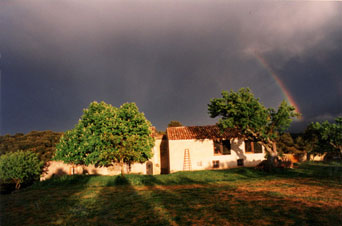
Our plot research group is currently high up in the clean air of the Plateau de Valensole in the Alpes of Haute Provence. Unfortunately, I’m stuck here at home writing and couldn’t free myself anymore from the schedule I’d already set for myself. So I’ll be participating à distance tomorrow via video conference from home. Seems I’m doing a lot of these sort of things recently, but of course for Plot it will be far more intimate than usual. In fact, I’m relishing the idea of teaching in the comfort of my pyjamas and a nice cup of hot tea — I think any teacher as invested as I am can appreciate the configuration. In fact, finding both temporally and spatially a human scale for real-time systems, is one of the implicit goals of plot, so we see no contradiction between serious research and a nice cup of hot tea.
One of the propositions that Fabrice Gallis made for this session was working specifically on machines that construct their own temporality, for example looking at a crypt as a temporal machine in the sense that it constructs it’s own specific durée, and even in this sense encloses that temporality within itself (I wonder what seepages might mean from such a point of view). One of the central propositions of Plot is that real-time is not an acceleration, but instead a temporal form, a sort of time-machine, if you will, generating its own emergeant temporality, but at multiple speeds, and not some ideal vector of absolute velocity. Although it’s been years since I studied with the infamous Jacques Derrida — and consider myself long since out of touch — I originally wondered if I shouldn’t crack open his Mal d’archive and see how it compares to Fabrice’s proposition. Now that I have, I regret it. One of Derrida’s gestures in Mal d’archive is to return to the originary scene of the archive where he finds a sort of ontological embalming that guarentees the dissapearance of the conserved object by its repetition, but also promises through this hypomnemic (and therefore technological) act of repetition a sort of future promise (a sort of impossible possibility). In probably the most indicative passage, he associates the archive with the historical arkhé, i.e. the archive as not only as a conservation of an origin, but also a commandement to conservation. I have no idea what to think of all this. All this talk of the Derridean concept of « promise » is so foreign, I think, to what we’re getting at here — ours is above all a Bergsonian concept of the temporal machine (there, I’ve said it). Again, it’s an affirmative machine, although in Derrida’s pseudo-romantic messianic vocabulary, he does make some interresting comments in a hilarious section speculating on what Freud’s method might have looked like if constructed atop the logics of AT&T and email. Here’s a translation I found online of this section which is closest to what Fabrice is proposing, « the technical structure of the archiving archive also determines the structure of the archivable content even in its very coming into existence and in its relationship to the future. The archivization produces as much as it records the event. This is also our political experience of the so-called news media. » Hmmm. Qu‘en penser ? Sure, okay, whatever — electronic media reaffirms to what extent hypomnema is a fundamental trait of our experience of (our) originality, and as such conditions our future (or its « possibility »). But Fabrice’s suggestion of a crypt goes far beyond Derrida’s typically not-this, not-that temporal structure, and allows us to actually construct temporal artefacts and systems. Hey, a crypt is a machine, it generates its own temporality. Easy enougj.
— Huh? Whazzahellwuzalldat for?
— Uhhhh, maybe it was just a long-winded way of saying: forget what I said at the last Plot…
